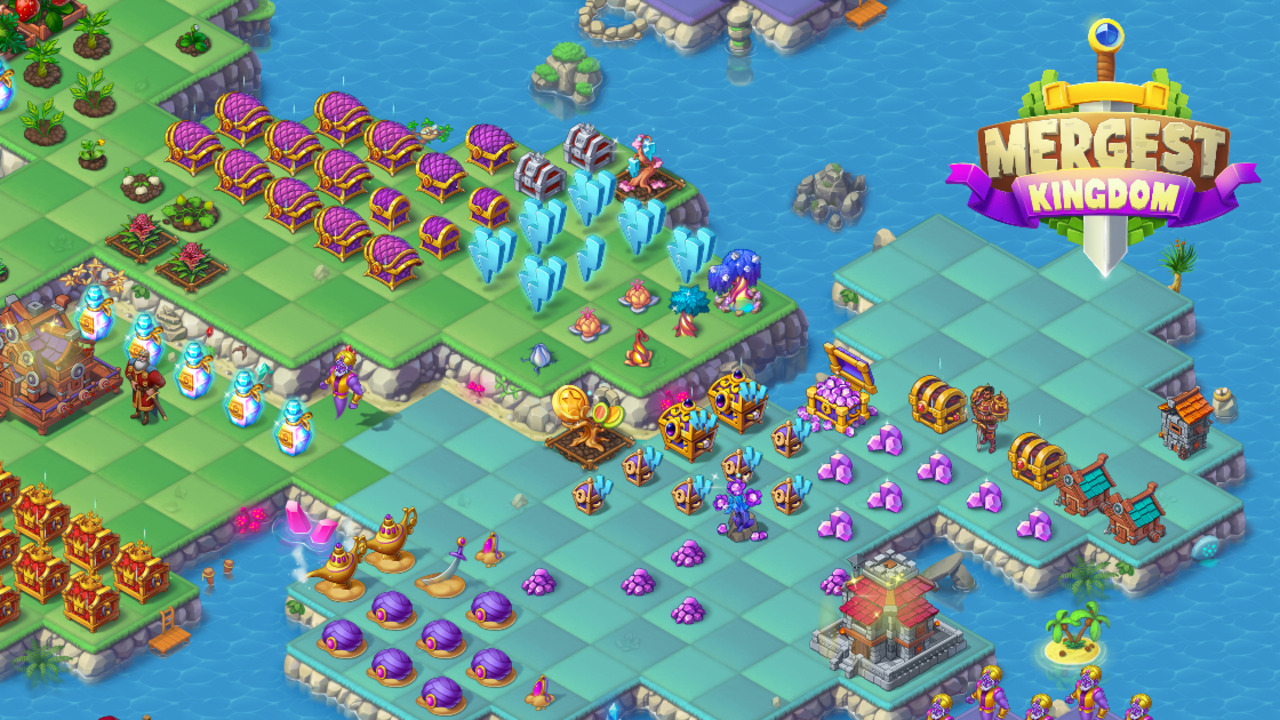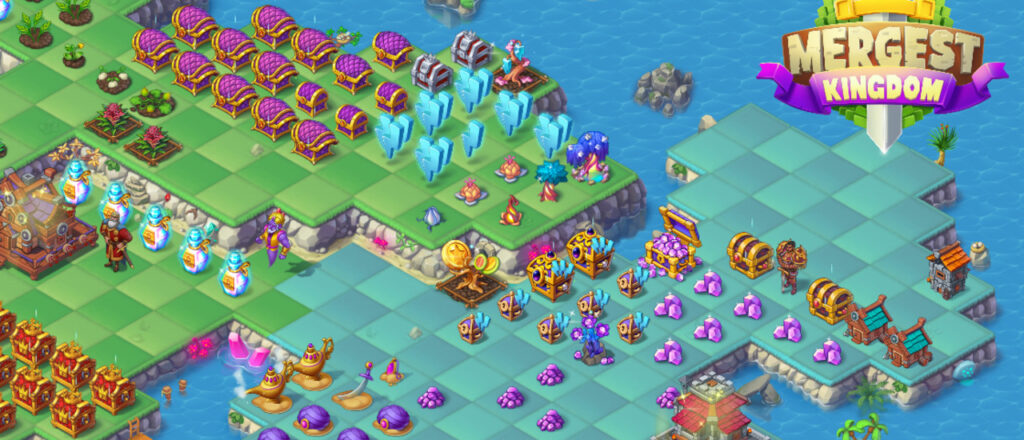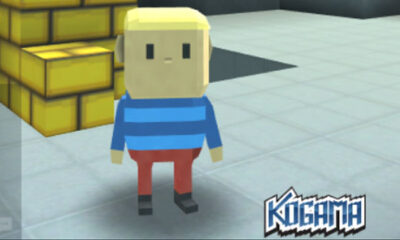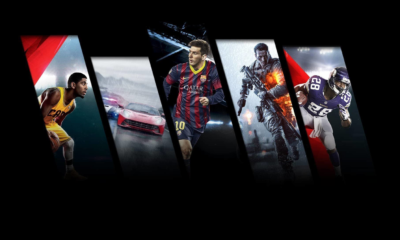Gaming
The Mergest Kingdom
Explore The Mergest Kingdom! Dive into a captivating merge game, unravel mysteries, and master the art of kingdom building.

Have you ever wished for a game that offers endless hours of fun? Look no further. Welcome to the magical world of “The Mergest Kingdom.” This game has quickly risen in popularity and it’s not hard to see why.
At first glance, The Mergest Kingdom might seem like just another merging game. But delve a bit deeper and you’ll find a rich tapestry of strategy and discovery. Every item you merge unlocks a new chapter in the game’s story. And each chapter brings a fresh twist to the gameplay.
The core of the game revolves around merging. From simple bushes to grand castles, everything can be merged. The more you merge, the more surprises you uncover. Each discovery encourages players to merge more and progress further.
But what sets The Mergest Kingdom apart from other games? It’s the balance between strategy and creativity. While merging helps in advancing, players also need to think about the best ways to manage and grow their kingdom. And that’s where the real fun begins.
So whether you’re a seasoned gamer or a newbie, This game has something for everyone. Its easy-to-understand mechanics make it accessible to all. Yet its depth keeps even the most experienced players hooked.
Mastering The Mergest Kingdom: A Step-by-Step Guide
A game that has been winning hearts and minds across the globe. If you’re new to the kingdom or just looking to sharpen your merging skills, you’re in the right place. This easy-to-follow guide will help you navigate the intricacies of the game, ensuring you rise to the top in no time.
The Heart of the Game: Gameplay Basics

- The Essence of Merging: The Mergest Kingdom thrives on the power of merging. From saplings to towering castles, the game nudges you to combine like items. As you merge, watch your kingdom expand and the storyline unfold in delightful ways.
- Story-driven Quests: While merging stands central, the storyline of the kingdom is the backbone. With each merge, you’ll uncover chapters of a gripping tale, adding layers to your gaming experience.
- Strategic Kingdom Building: Merging isn’t just about combining items. Think of it as a strategy. As your realm grows, you’ll need to make choices. What to merge? Where to place new items? When to expand? The answers lie in strategic gameplay.
Holding the Reins: Key Game Controls
- Touch, Drag, and Merge: The control is in your fingertips. Tap an item, drag it atop a similar one, and witness the magic of merging. It’s as simple as that. The drag-and-drop mechanism ensures even beginners can play with ease.
- Panorama View: Slide your fingers to roam around your burgeoning kingdom. A simple pinch lets you zoom in or out, ensuring you never miss out on any corner of your realm.
- Engage with Menus: Icons, usually nestled at the screen’s edge, usher you into various menus. Check progress, embark on quests, or tweak settings – it’s all a tap away.
Climbing the Ladder: Delving into the Levels of The Mergest Kingdom
Each level is a new adventure, a fresh challenge, and a unique tale in itself. Let’s ascend through the hierarchy of game’s levels.
Beginner’s Grove: The Starting Saga – The journey starts here. These levels acquaint you with the basics of merging, offering relatively simple tasks to help you find your footing in the game. It’s where you’ll make your first merges and witness the blossoming of your kingdom.
Mystical Meadows: Mid-Tier Marvels – As you advance, the challenges become intriguing. The Mystical Meadows section demands more than just merging. Here, strategy plays a pivotal role. You’ll encounter puzzles, unlock new items, and maybe even face some delightful surprises.
Enchanted Empires: Advanced Adventures – The terrain gets trickier, the merges more complex, and the rewards? Oh, they’re absolutely worth it! This is where seasoned players test their mettle, applying their refined strategies, and diving deep into the game’s intricacies.
Legendary Lands: The Pinnacle of Play – The cream of the crop. These levels aren’t for the faint-hearted. Every merge counts, every decision can change the course of your kingdom’s fate, and every level conquered feels like a real achievement. It’s the ultimate merging challenge.
Mastering Merges: Top Tips & Tricks for The Mergest Kingdom
- Prioritize Five-Item Merges: Merging five items at once offers more rewards than merging three.
- Maximize Camp Space: Keep your camp organized and clear out unnecessary items to optimize space.
- Complete Daily Quests: Engage in daily quests for exclusive rewards and faster progress.
- Save Gems for Essentials: Instead of spending gems impulsively, save them for essential items or tasks.
- Harvest Wisely: Only harvest from advanced plants or structures to get the best resources.
- Expand Your Territory: Always look to unlock new pieces of land to access more resources and challenges.
- Optimize Merging Chains: Initiate chain merges by strategically placing items to maximize merging output.
- Engage in Events: Participate in time-limited events for unique items and bonuses.
- Avoid Quick Merges: Manually merge items to ensure you’re always making the most beneficial combinations.
- Study Your Items: Familiarize yourself with items and their merge chains to plan better strategies.
Kingdom Chronicles: Standout Features of The Mergest Kingdom
- Dynamic Merging Mechanics: Experience a unique merging system that evolves as you progress.
- Engaging Storyline: Dive deep into a captivating narrative that unveils with each merge.
- Stunning Graphics: Immerse yourself in visually appealing landscapes and detailed item designs.
- Interactive Events: Participate in time-bound events that offer exclusive rewards and fresh challenges.
- Expansive Game World: Discover a vast realm with diverse landscapes and hidden territories to unlock.
- Strategic Gameplay: Beyond merging, the game tests your planning and resource management skills.
- Daily Quests & Challenges: Keep engaged with daily tasks that promise generous rewards.
- Rich Soundscapes: Enjoy immersive soundtracks and effects that complement the game’s magical ambiance.
- Diverse Items Catalog: Explore a wide variety of items, each with its own unique merge chain and purpose.
- Community Engagement: Connect with players worldwide, share strategies, and build a collective gaming experience.
FAQs
What is The Mergest Kingdom?
It is a captivating merging game where players combine like items to progress, expand their territory, and unravel a unique storyline.
How do I get more space in my camp/kingdom?
Players can unlock additional space by progressing through levels, completing certain challenges, or sometimes through in-game purchases.
Are there in-game purchases in The Mergest Kingdom?
Yes, it offers in-game purchases which can help players progress faster, acquire unique items, or expand their game world.
Can I play the game offline?
While the primary gameplay can often be accessed offline, certain features, updates, or events might require an internet connection.
How can I save my game progress?
Connecting your game to an account or social media platform can help in securing your progress and accessing it across devices.
Wrapping Up the Kingdom’s Wonders
Navigating the enchanting landscapes of The Mergest Kingdom has been a treat. Each merge reveals a new surprise. Each level takes us on a unique journey. It’s not just about strategic gameplay. It’s about immersing oneself in a realm of magic and discovery. With every tap and drag, stories unfold. Challenges arise. And the charm of the kingdom pulls us deeper. Dive back in. Let the adventures continue. The kingdom’s tales are far from over.
People Also Searched For
- Slope Unblocked Games
- Moto X3m
- 1v1.lol Unblocked 66
- Fireboy And Watergirl Unblocked
- Happy Wheels Unblocked Games
- Minecraft Unblocked Games 66
- Drift Hunters Unblocked
- Tunnel Rush Unblocked
- Eggy Car Unblocked 66
- Google Baseball Unblocked
- Fall Boys Unblocked
- Bouncy Rush
- Cookie Clicker Unblocked Games
- Pixel Combat 2
- Little Alchemy 2
- Subway Surfers Unblocked
- Planet Clicker 2
- Retro Bowl Unblocked
- Big Tower Tiny Square Unblocked
- Rooftop Snipers Unblocked
- Getaway Shootout Unblocked
- Papa’s Cheeseria
- Heardle Game
- Iron Snout Unblocked
- Basketball Legends
- Flappy Bird Unblocked
- Highway Racer
- Geometry Dash Unblocked
- Crazy Shooters
- Basketball Stars Unblocked
- Rummy Wealth
- Among Us Unblocked
- 8 Ball Pool Unblocked
- Garden Tales
- Mahjong Connect
- Coin Clicker
- Tetris Unblocked
- Chess Unblocked
- Stickman Hook Unblocked
- Mario Unblocked
- Tiny Fishing Unblocked
- Bob The Robber Unblocked
- Fortnite
- io Unblocked Games
- 2048 Unblocked
- Cricmania
- Smash Karts Unblocked
- Drive Mad Unblocked
- Tallman Run
- Monkey Mart
- Snow Rider 3D Unblocked
- Unblocked Games WTF
- Unblocked Games
- Crossy Road Unblocked
- Cat Ninja Unblocked
- Slither.io Unblocked
- Penalty Shooters 2
- Worlds Hardest Game Unblocked
- Vex 3 Unblocked
- Ping Pong Unblocked
- Backflip Maniac
- Unicycle Hero Unblocked
- Rocket League Unblocked
- Game Online Gratis
- 66 Unblocked Games
- Google Tic-Tac-Toe
- hole io unblocked
- FNF Unblocked
- Cricket Legends
- Pacman 30th Anniversary
- Pacman Unblocked
- Fly or Die
- Bitlife Unblocked
- Sausage Flip Unblocked
- Drift Boss Unblocked
- Madalin Stunt Cars 2 Unblocked
- Paper io Unblocked
- Granny Unblocked
- krunker.io unblocked
- G Switch
- Temple of Boom
- Shell Shockers Unblocked
- Eaglercraft
- Pocket Emo
- Rolling Ball 3D Unblocked
- Blackjack Unblocked
- Roblox Unblocked
- Traffic Jam 3D
- Tomb Runner
- Super Smash Flash 2 Unblocked
- Unblocked Games 911
- Yummy Tales 2
- Block Champ
- Dinosaur Game Unblocked
- Moto Road Rash 3D Unblocked
- Merge Fruit
- Cat Runner
- Love Tester 3
- Sniper 3D
- Woodoku
- Drunken Boxing
- Top Speed Racing 3D
- Mini Golf Game
- FNAF Unblocked
- Basketball Random Unblocked
- Happy Snakes
- Sugar Heroes
- Going Balls
- Bus Driver Simulator
- Vex 7 Unblocked
- Geometry Jump
- Sonic Mania Plus Mod APK Download
- A Small World Cup Unblocked
Gaming
Inhouse Dice 99 RTP Christmas Edition Bounties

Introduction
On December 19, Rollhub launches its Christmas Edition Dice Bounties, centered around the platform’s inhouse Dice 99 game with a 99 RTP. Designed and operated entirely within the Rollhub ecosystem, Dice is one of the platform’s core provably fair games, offering fast gameplay, precise control, and transparent outcomes.
This seasonal promotion introduces a structured bounty system that rewards wagering activity across multiple participation levels. By combining festive visuals with clearly defined objectives, the Dice Bounties campaign reinforces Rollhub’s focus on in-house development, predictable RTP performance, and straightforward reward mechanics throughout the holiday period.
Dice Special Bounty High Wager Reward Challenge
The Special Bounty tier is designed for players aiming for higher wagering volume and premium rewards. With a $20,000 wagering requirement, participants can earn a $200 bounty reward, making this the highest-tier challenge within the Dice Christmas Edition promotion.
This tier highlights the advantages of a 99 RTP in-house game, where increased activity is aligned with clearly structured rewards and stable, predictable mechanics.
Dice Standard Bounty Entry Level Promotion
For players looking for an accessible entry point, the Standard Bounty offers a balanced participation option. By completing a $100 wagering requirement, users can earn a $1 bounty reward, encouraging steady engagement without a high initial commitment.
This tier serves as the foundation of the Dice Bounties campaign, enabling a wide range of players to participate while benefiting from the game’s high RTP structure.
Dice Token Bounty Rollhub Reward Integration
The Token Bounty integrates Dice gameplay directly with the Rollhub reward ecosystem. With a $40 wagering requirement, players can earn 2,026 Rollhub tokens, adding an additional incentive layer beyond traditional cash-based rewards.
This option supports long-term engagement by allowing earned tokens to be used across the Rollhub platform, strengthening the connection between inhouse games and platform-wide incentives.
Conclusion
The Christmas Edition Dice Bounties combine in-house game development, a 99 RTP framework, and clearly structured bounty tiers to deliver a transparent and engaging seasonal promotion. With multiple participation levels and reward formats, Rollhub allows players to choose their preferred strategy while maintaining full visibility into how rewards are earned.
To stay updated on ongoing promotions, upcoming bounty opportunities, and additional bonus releases, users are encouraged to join the Rollhub Telegram group, where updates and exclusive offers are shared regularly. The Dice Bounties promotion is live as of December 19 and available to all Rollhub users.
Gaming
Kesalahan Bonus Paling Umum yang Dilakukan Pemain dan Cara Mahadewa88 Membantu Memaksimalkan Setiap Promosi

Bagi sebagian besar pemain online, bonus adalah bagian paling menyenangkan ketika bergabung dengan platform gaming. Kredit tambahan, putaran gratis, cashback, atau promosi khusus memberikan kesan seperti jalan pintas menuju kemenangan besar. Namun, kenyataannya, bonus bisa bekerja untuk Anda atau justru merugikan, tergantung pada cara Anda menggunakannya. Sayangnya, banyak pemain terus terjebak dalam kesalahan yang sama saat mengelola bonus—tanpa menyadarinya.
Kabar baiknya? Platform yang tepat dapat membantu Anda menghindari kesalahan ini. Mahadewa88 (www.mahadewa88.com) menyediakan cara paling efektif bagi pemain untuk memanfaatkan bonus. Dengan aturan yang transparan, struktur promosi yang cerdas, dan alat bonus yang ramah pengguna, Mahadewa88 memastikan setiap pemain dapat memaksimalkan setiap kesempatan bonus.
Sebelum membahas bagaimana Mahadewa88 membantu, mari kita lihat kesalahan umum yang sering dilakukan pemain—yang terkadang bisa merugikan uang asli.
1. Mengabaikan Syarat dan Ketentuan
Ini adalah kesalahan bonus nomor satu dan lebih sering terjadi daripada yang disadari pemain. Banyak pemain terburu-buru saat klaim bonus tanpa membaca berapa kali deposit harus diputar atau permainan apa saja yang berlaku. Misalnya:
- Bonus mungkin hanya berlaku untuk game tertentu
- Penarikan memerlukan turnover tertentu
- Beberapa taruhan tidak dihitung untuk wagering
- Bonus bisa kedaluwarsa lebih cepat dari perkiraan
Cara Mahadewa88 Membantu:
Mahadewa88 menampilkan syarat bonus dengan jelas di setiap halaman promosi. Setiap bonus dilengkapi penjelasan sederhana, sehingga pemain tahu persis apa yang mereka dapatkan—tanpa aturan membingungkan atau jebakan tersembunyi.
2. Mengklaim Semua Bonus Tanpa Strategi
Beberapa pemain percaya bahwa mengklaim semua bonus yang tersedia otomatis meningkatkan peluang menang. Padahal, hal ini sering berbalik merugikan.
- Persyaratan wagering menjadi terlalu rumit
- Bankroll tersebar terlalu tipis
- Pemain terjebak dalam siklus turnover panjang
- Penarikan bisa gagal karena banyak kondisi aktif
Cara Mahadewa88 Membantu:
Mahadewa88 memungkinkan pemain memilih promosi sesuai strategi mereka. Baik bonus slot, promosi sportsbook, atau cashback, Anda bisa mengaktifkan satu per satu melalui dashboard pengguna. Ini membuat pemain tetap mengontrol bonus tanpa merasa kewalahan.
3. Mengejar Bonus dengan Wagering Tinggi
Bonus besar tidak selalu lebih baik. Beberapa platform menarik pemain dengan angka menggiurkan, seperti 200% atau 500% bonus, tetapi menyembunyikan persyaratan wagering yang sangat tinggi. Hasilnya:
- Terjebak dalam siklus turnover yang mustahil
- Membangun ekspektasi tidak realistis
- Kehilangan lebih banyak uang mencoba memenuhi persyaratan
Cara Mahadewa88 Membantu:
Promosi di Mahadewa88 disusun dengan adil. Target wagering realistis dan persyaratan turnover bisa dicapai, sehingga pemain dapat menikmati reward, bukan berjuang melewati persyaratan yang mustahil.
4. Lupa Waktu Kedaluwarsa Bonus
Bonus tidak bertahan selamanya. Banyak pemain:
- Mengaktifkan bonus tapi lupa memainkannya
- Tidak cukup bermain untuk menyelesaikan turnover tepat waktu
- Kehilangan nilai bonus karena manajemen waktu yang buruk
Cara Mahadewa88 Membantu:
Mahadewa88 menyediakan countdown timer dan notifikasi kedaluwarsa. Pemain dapat memantau semua bonus dan tidak akan melewatkan batas waktu.
5. Bermain Game yang Tidak Mendukung Progress Wagering
Tidak semua game berkontribusi sama pada persyaratan bonus. Beberapa game:
- Memberikan kontribusi 100%
- Hanya 20%
- Atau bahkan 0%
Banyak pemain menggunakan bonus pada game yang tidak membantu menyelesaikan persyaratan, sehingga progres sangat lambat.
Cara Mahadewa88 Membantu:
Mahadewa88 menandai game yang dihitung untuk turnover. Pemain bisa memilih slot, live casino, atau taruhan olahraga yang benar-benar mendekatkan mereka pada penyelesaian bonus.
6. Bertaruh Terlalu Besar Terlalu Cepat
Kesalahan umum lainnya adalah menggunakan dana bonus secara sembrono, menganggapnya “gratis.” Akibatnya:
- Mengambil risiko yang tidak perlu
- Bankroll cepat habis
- Wagering sulit diselesaikan
Cara Mahadewa88 Membantu:
Platform mendorong taruhan cerdas dengan alat yang melacak progres wagering dan menampilkan informasi bankroll. Interface Mahadewa88 memudahkan pemain menyesuaikan ukuran taruhan dan tetap mengontrol permainan.
7. Tidak Memanfaatkan Bonus Cashback
Banyak pemain tidak menyadari nilai cashback. Cashback melindungi bankroll dengan mengembalikan sebagian kerugian, namun sering diabaikan.
Cara Mahadewa88 Membantu:
Mahadewa88 menawarkan cashback secara konsisten dengan aturan yang jelas, sehingga setiap sesi permainan lebih aman dan menguntungkan.
8. Lupa Mengecek Promosi Harian dan Mingguan
Beberapa pemain hanya fokus pada bonus selamat datang dan mengabaikan reward rutin yang biasanya lebih menguntungkan dalam jangka panjang.
Cara Mahadewa88 Membantu:
Mahadewa88 selalu menyajikan promosi baru seperti:
- Bonus harian
- Cashback mingguan
- Event musiman
- Reward anggota spesial
Promosi ditampilkan di homepage mahadewa88.com, sehingga pemain tidak akan melewatkannya.
Mengapa Mahadewa88 Memaksimalkan Setiap Bonus
Kesalahan bisa terjadi, tetapi platform yang tepat dapat mencegahnya. Mahadewa88 unggul karena menyediakan:
✔ Detail bonus transparan
✔ Persyaratan wagering adil dan realistis
✔ Alat pelacakan bonus
✔ Panduan kontribusi game yang mudah dibaca
✔ Fitur cashback terpercaya
✔ Promosi harian dan mingguan konsisten
✔ Lingkungan aman dan ramah pengguna
Baik Anda bermain untuk bersenang-senang atau setiap hari, Mahadewa88 memastikan Anda mendapatkan nilai maksimal dari setiap bonus.
Kesimpulan
Bonus seharusnya menambah keseruan bermain, bukan menambah komplikasi. Dengan menghindari kesalahan umum dan memilih platform yang adil serta transparan, pemain bisa menikmati setiap promosi secara optimal. Dengan sistem cerdas, aturan jelas, dan fitur yang mengutamakan pemain, Mahadewa88 memberikan kesempatan bagi setiap pengguna untuk memaksimalkan bonus tanpa stres.
Jika Anda mencari situs di mana promosi benar-benar menguntungkan, tidak perlu mencari lagi selain https://mahadewa88.com/.
Gaming
Key Features That Define a Quality Online Casino Experience

When players talk about online casinos, the conversation often jumps straight to bonuses or flashy game titles. But in practice, the overall experience depends on a mix of smaller details that shape how comfortable players feel while using the platform. While some of those details are obvious; others only become noticeable after you’ve spent time browsing.
A good casino finds a balance between technical reliability, fairness, and user comfort. These traits aren’t always front and center, but they’re what stick with players. Below is a closer look at the features that consistently set better casinos apart from the rest.
Fair Play Standards and Honest Terms
Because fairness is usually only questioned when something goes wrong, reputable casinos rely on independent testing agencies to prevent those concerns. These groups verify that the random number systems behave as they should. The presence of certification doesn’t guarantee perfection, but it does show the casino is willing to open its doors to scrutiny.
Transparency is another key factor to consider. While some casinos bury important rules in legal jargon, others make an effort to present them clearly and simply. Clear terms help players understand how bonuses work and what to expect when withdrawing money. It makes the experience feel more grounded and easier to follow.
Game Selection and Reliable Developers
A strong selection of games is usually a sign that a casino takes its role seriously. Not every player wants the same thing, and variety helps the platform appeal to different moods and interests. Ideally, the casino offers a reasonable mix of choices instead of leaning too heavily on one category.
Each game comes from a specific developer, and that’s where quality really shows. Trusted providers have been around for years, delivering smooth, fair titles that get updated regularly. Players who use platforms such as FanDuel Casino will notice multiple familiar studios in the lineup. It’s not just about having many games; it’s about having games supported by companies that maintain standards.
Layout, Navigation, and Overall Ease of Use
It’s easy to overlook interface design until it creates a problem. A cluttered layout can make even the best casino feel unwelcoming. The better platforms take a more thoughtful approach. Menus are arranged logically, pages load without hesitation, and players aren’t forced to dig around for basic features like account settings or banking options.
Visual simplicity tends to age better than flashy graphics. Clean lines, calm color schemes, and readable text help players stay focused on the games rather than the design. A good site doesn’t draw attention to itself, it simply makes the player’s actions easier. When navigation feels effortless, players can settle in faster and stay longer without frustration.
Mobile Performance and Device Flexibility
A significant share of casino play now happens on mobile devices, sometimes during short breaks or while commuting. Because of that, a casino’s mobile performance is no longer a secondary feature. It’s central to the experience. Pages that adapt cleanly to smaller screens, games that maintain their quality, and buttons that are easy to interact with all contribute to a smoother game session.
Apps can help, but they’re not the only measure of quality. Plenty of strong casinos rely solely on well-optimized browser versions that run consistently across devices. The important part is whether the casino feels stable. Lag, dropped connections, or distorted layouts pull players out of the experience. Reliability across devices is often a clear indicator of how much attention the casino pays to its infrastructure.
Secure Banking and Realistic Withdrawal Timelines
Banking features don’t usually show up on promotional banners, yet they influence trust more than any bonus ever could. At minimum, a casino should protect financial data through proper encryption and offer methods players already know; cards, bank transfers, digital wallets, and so on. A system that feels familiar tends to feel safer.
Withdrawals are where players form their strongest opinions. Slow processing or vague explanations about delays can overshadow an otherwise decent platform. A reliable casino provides clear timelines and generally meets them. It avoids hidden fees and doesn’t create unnecessary roadblocks.
When the financial side runs smoothly, players can focus more on entertainment and less on anxieties about their money.
Practical Customer Support and Player Resources
Support teams are often overlooked until an issue arises, yet timely and effective assistance plays a significant role in shaping a player’s perception of the casino. The best platforms keep support easy to reach and staff it with people who can give helpful answers instead of scripted replies. Even small issues feel less stressful when support treats them with care.
Support availability matters as well. Players log in at all hours, and a support system that only works during narrow windows isn’t ideal. A detailed FAQ section often helps with routine questions, reducing the need for direct contact. When support works well, it gives the casino a more dependable feel overall.
A Final Word for Players
Most casinos offer similar promises on the surface. The real differences appear in how they handle fairness, usability, mobile play, banking, and support. These are the details that shape the experience day-to-day.
When a platform manages them well, it creates a space where players feel more at ease and more willing to return. Keeping these factors in mind helps distinguish casinos that are genuinely player-focused from those that merely aim to appear so.
-

 Finance3 years ago
Finance3 years agoProfitable Intraday Trading Advice For Novices
-

 Gaming3 years ago
Gaming3 years agoSubway Surfers Unblocked | Subway Surfers Unblocked 66
-

 Internet3 years ago
Internet3 years agoWelcome to banghechoigame.vn – Your One-Stop Destination for Online Gaming Fun!
-

 Gaming3 years ago
Gaming3 years agoMinecraft Unblocked Games 66 | Unblocked Games Minecraft
-

 Gaming3 years ago
Gaming3 years agoGoogle Baseball Unblocked | Google Doodle Baseball Unblocked 66
-

 Internet2 years ago
Internet2 years agoPremium Games Unblocked: Unleash Your Gaming Potential
-

 Gaming3 years ago
Gaming3 years agoTunnel Rush Unblocked | Tunnel Rush Unblocked 66
-

 Gaming2 years ago
Gaming2 years agoRocket League Unblocked – Rocket League 2D Unblocked

